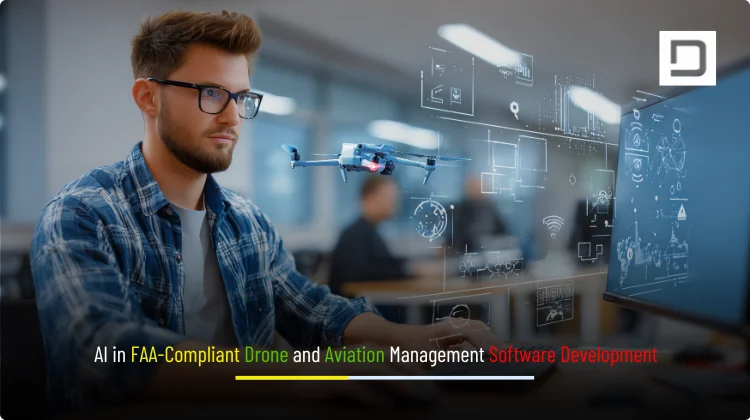AI in FAA-Compliant Drone and Aviation Management Software Development
Aviation Management Software Development is going through a major shift. Artificial Intelligence is now at the center of modern flight management, drone operations, airspace safety, predictive maintenance, pilot compliance, and regulatory reporting. In commercial aviation and in unmanned aircraft systems, AI is no longer just an add-on feature. AI is shaping how entire fleets are managed, how incidents are prevented instead of reacted to, and how companies stay compliant with strict FAA rules without slowing down operations.
In this blog, we will explore how AI-driven aviation management platforms are built, why FAA compliance matters at every layer of the software architecture, and how AI improves both safety and profitability. We will also explain how software teams like Depex Technologies approach Aviation Management Software Development so that the final product is audit-ready, future-ready, and commercially scalable.
What is FAA-compliant aviation management software
FAA-compliant aviation management software is a digital control system that helps operators manage everything related to aircraft or drone operations while following Federal Aviation Administration rules. The FAA creates and enforces air safety regulations in areas such as pilot certification, aircraft maintenance, remote ID, airspace permissions, and incident reporting. Any serious Aviation Management Software Development effort for the United States market must respect those regulations by design, not as an afterthought.
A modern aviation management platform typically connects several modules into one central dashboard. These modules include flight planning, airspace authorization, maintenance tracking, fleet health, crew management, risk assessment, weather intelligence, compliance reporting, and billing or cost accounting. When this platform is used for drone operations, it can also include live telemetry, geofencing, visual line of sight checks, and automated no-fly zone enforcement.
AI enhances each of these modules in different ways. Instead of just storing data, the platform becomes proactive. It starts to recommend actions, flag violations before they happen, and protect the operator from costly mistakes that lead to fines, license suspensions, insurance claims, or in the worst case, safety incidents.
When we talk about FAA-compliant software, we are not only talking about a checkbox for regulations. We are talking about building trust. The FAA wants to see that operators follow the rules. Enterprise clients want to see that flight operations are safe, predictable, and well documented. Insurers and investors want to see risk under control. Strong Aviation Management Software Development with AI and compliance at its core delivers that trust.
Why AI matters in aviation management
AI changes aviation operations in three fundamental ways: safety, efficiency, and compliance.
Safety is the first layer. Aviation is a high-risk environment. In both manned and unmanned systems, a single point of failure can lead to mission failure, asset loss, or human injury. AI can reduce risk by analyzing telemetry data in real time, predicting component fatigue, recommending route adjustments during flight, and escalating warnings when thresholds are crossed. Instead of discovering a problem after a mission, AI can surface the warning before takeoff or during mid-flight.
Efficiency is the second layer. Airlines, private charters, air cargo companies, drone delivery services, and infrastructure inspection teams all face cost pressure. AI helps consolidate planning, crew scheduling, airspace approvals, and mission execution so that more missions can be flown with fewer delays. AI does not simply automate paperwork. It optimizes usage of aircraft, pilots, batteries, and maintenance slots to remove hidden downtime.
Compliance is the third layer. FAA compliance is strict, and it is getting even stricter in areas like drone operations and beyond visual line of sight permissions. Manual compliance management is slow and expensive. AI can continuously monitor whether a mission plan or current flight is compliant with FAA rules based on airspace, altitude, distance from people, pilot requirements, and equipment standards. This lowers legal exposure and protects operating licenses.
In short, AI makes aviation management software safer, smarter, and audit-ready.
AI for flight planning and mission control
One of the most valuable parts of Aviation Management Software Development is mission planning. Mission planning means deciding when, where, and how to fly before the aircraft actually launches. In traditional systems, a flight planner or drone operator creates a route manually, checks airspace manually, checks NOTAMs manually, checks weather manually, and then documents everything to prove compliance.
AI changes that workflow.
AI can generate an optimal route automatically using live airspace data, restricted zones, terrain, and forecast weather. For drones, AI can ensure that the route stays within allowed altitude, stays within line of sight if required, and avoids emergency response zones and temporary flight restrictions. For charter aircraft, AI can recommend fuel strategy, alternates, and routing adjustments to reduce turbulence risk and avoid delays.
AI can also simulate the mission before it happens. If the mission is not compliant, the system can block launch and explain the reason in plain language. For example: “This mission violates FAA altitude limits for this class of airspace. Maximum allowed is 120 meters above ground in this area.” This lowers the chance that a pilot or operator accidentally violates a rule out of ignorance or pressure.
Another mission control benefit is dynamic re-planning. Conditions change during flight. Weather shifts. An event creates a new restricted area. A battery heats up faster than normal. AI can monitor these signals and suggest a safe reroute in real time, before the issue becomes critical. This real-time advisory layer is one of the most important differentiators of AI-driven aviation management, because it protects both the asset and the operator.
AI for maintenance and predictive health
Maintenance tracking is one of the areas where AI gives measurable financial value. Every aircraft, whether crewed or unmanned, has components with life limits. Motors degrade. Batteries lose capacity. Propellers, rotors, sensors, and avionics drift from original calibration. If operators wait for a component to fail, they risk mission failure, forced grounding, or emergency landing. If they replace components too early, they waste money on parts and labor.
AI solves that balance.
An AI-powered maintenance module can collect flight logs, vibration data, motor temperature data, torque data, and battery discharge curves across every mission. Over time, the system learns what “normal” looks like for a specific aircraft model under a specific payload and flight style. When it detects a pattern that predicts future failure, it can raise a maintenance alert.
Instead of generic checklists like “inspect every 20 hours,” AI can produce targeted instructions such as “Replace left rotor assembly within the next 3 hours of flight time to avoid performance drop.” That is powerful because it turns maintenance into a planned activity instead of an emergency.
This approach also supports FAA compliance. FAA audits are very serious about airworthiness and maintenance tracking. With strong Aviation Management Software Development, every alert and every action is logged. That log is timestamped, connected to the aircraft ID, the technician name, and the part life cycle. During audit or investigation, operators can show complete traceability.
Another advantage is part inventory prediction. The system can forecast which spare parts will be needed in the next 30 days and suggest procurement in advance. For drone delivery companies or inspection companies that operate dozens or hundreds of identical aircraft across multiple regions, this prevents grounded units due to missing spares.
AI for pilot, crew, and operator compliance
Compliance is not just about the aircraft. It is also about the people flying it. FAA rules specify who is allowed to fly in certain conditions, what certifications are needed, what training must be logged, and whether fatigue rules or duty limits apply.
In a traditional manual process, these checks live in spreadsheets and shared folders. This creates risk, because one missed update can expose the whole organization.
In an AI-enabled aviation management platform, crew compliance becomes automated.
Before any scheduled mission, AI can check:
- Does the assigned pilot or remote operator have the correct certification for this mission profile
- Has that certification expired
- Has the pilot logged required currency or training hours in the last defined period
- Is the operator within duty-hour limits for the day
If any answer is not compliant, the system can block assignment. This protects the company from accidental rule violations. It also protects the pilot, because it removes pressure to “just fly it” even if a requirement is not met.
For enterprise fleets, this also becomes a reporting advantage. During audits, insurance reviews, or contract negotiations, leadership can immediately prove that every mission was flown by a qualified operator whose credentials were valid at the time of launch. This level of traceability builds trust with regulators, enterprise clients, and government buyers.
AI for situational awareness and live monitoring
Live situational awareness is vital for both traditional aviation and drone operations. During active missions, the operations center needs to know what is happening in the air, what risks are emerging, and which responses are required.
AI takes data from live telemetry, onboard sensors, ADS-B signals, onboard cameras, weather feeds, and geofencing maps, and turns it into a single operational picture that humans can actually act on.
Consider these examples:
The AI identifies that an unmanned aircraft is approaching a temporary flight restriction that was not in the original plan. Instead of waiting for a violation, it can generate an instant alert and suggest a heading correction that keeps the mission compliant.
The AI sees that a battery temperature curve is rising faster than expected while the drone is still at altitude. It can advise an early return-to-home while there is still safe margin, instead of risking an emergency landing.
The AI detects unexpected manned aircraft nearby in low altitude airspace. It can warn the drone operator with a clear instruction such as “Descend to pre-approved safety altitude immediately to avoid proximity conflict.”
In crewed aviation, similar logic can apply to runway congestion, weather cells, and turbulence patterns. AI can help dispatch teams and pilots make smarter decisions to avoid costly diversions and delays.
This level of real-time assistance is not only operationally useful. It is also part of FAA safety culture. The FAA expects operators to show that they are using every available tool to mitigate risk. AI gives documented proof that risk mitigation is active and continuous.
AI for regulatory reporting and audit trails
Every flight creates data. Airspace approvals, pre-flight checklists, operator assignments, maintenance logs, incident notes, battery cycle counts, payload declarations, environmental conditions, and more. FAA-compliant Aviation Management Software Development treats that data as evidence.
Evidence matters during routine audits. It is just as important after an incident. The same proof is required when applying for advanced operational waivers, such as beyond visual line of sight flights, cargo delivery in populated areas, or night operations.
AI helps automate and structure that evidence.
Instead of asking staff to manually generate post-flight reports, AI can build a complete mission report automatically. The report can include mission purpose, planned route versus flown route, operator identity, aircraft status, alerts triggered, corrective actions taken, and confirmation that the mission stayed within approved conditions.
Because the report is machine-generated from live data logs, it is consistent. Because it is consistent, it scales. Large operators can produce hundreds or thousands of mission records per month without needing a full-time documentation team.
There is also another benefit. When a company applies for FAA waivers or renewals, being able to show this level of documentation improves credibility. Regulators are more willing to grant advanced operational permissions to companies that can prove repeatable safety discipline through strong software.
AI for cost control and business intelligence
Safety is essential, but aviation is also a business. Whether the organization is moving cargo, inspecting infrastructure, assisting public safety, providing charter services, or delivering critical goods like medical supplies, money matters. The cost model must make sense.
AI-driven aviation management turns operational data into business intelligence.
For example, AI can track cost per mission at a very granular level. Cost can include fuel or battery energy, pilot or operator time, takeoff and landing fees, maintenance time, part wear, transit to and from launch location, and even regulatory overhead such as notification processes. Over time, patterns emerge. Management can see which mission types are profitable, which routes are inefficient, and which assets are underused.
AI can also forecast fleet capacity. If a company expects a certain mission volume next quarter, the system can simulate whether the current fleet can support that volume under FAA duty limits, maintenance windows, and crew schedules. This allows leadership to make data-backed expansion decisions instead of guessing.
This is extremely valuable for scaling drone delivery or drone inspection businesses. Many of these businesses start with proof-of-concept flights and then struggle when they try to scale to city-wide or state-wide coverage. Without AI, scheduling becomes chaotic and margins collapse. With AI, scheduling becomes precise and growth becomes predictable.
This kind of financial clarity turns aviation from “cool tech” into a repeatable, bankable service.
How FAA compliance shapes software architecture
FAA compliance is not only a legal topic. It affects how the software itself is designed. When Depex Technologies approaches Aviation Management Software Development, we build for compliance at the data layer, logic layer, and interface layer.
At the data layer, the system must log and store mission data in a secure and traceable way. Timestamps, aircraft IDs, operator IDs, and alert states must be preserved. Tampering should be detectable. Data retention rules must be respected. Access control must be role-based, so that unauthorized staff cannot change historical records. This protects the integrity of evidence.
At the logic layer, AI models must be explainable. If the AI blocks a mission, it should say why in operational language. “Blocked due to missing Part 107 certification for assigned operator for this class of mission” is a useful, auditable message. “Mission denied due to AI confidence threshold” is not. The FAA cares about transparency. So does insurance. So do courts.
At the interface layer, workflows must guide the user into compliant behavior by default. For example, the interface should not allow an operator with expired credentials to be assigned to a high-risk mission. The interface should show real-time airspace restrictions clearly on the map during mission planning. The interface should highlight any deviations from approved mission plans in real time.
By baking these rules into the product experience, we do not rely on memory or manual discipline. The software itself becomes a safety barrier.
FAA, drones, and Remote ID
Any serious conversation about AI and aviation software today must include Remote ID for drones. Remote ID is essentially a digital license plate broadcast by unmanned aircraft during flight. It allows authorities to identify and track drones in the airspace for safety and security reasons.
An FAA-compliant drone management platform must support Remote ID. From a software standpoint, that means tracking Remote ID broadcast data, attaching it to flight records, and maintaining that record in a compliance-friendly format.
AI helps in two more ways here.
First, AI can alert if a drone is flying without an active Remote ID broadcast in airspace where Remote ID is required. This prevents regulatory violations in real time.
Second, AI can analyze Remote ID data from nearby aircraft to detect crowding, conflict risk, or unauthorized drones in sensitive locations. For operators who work in areas like utilities, border security, or emergency response, this situational intelligence is extremely valuable.
Remote ID is a clear example of how new FAA rules generate new technical requirements. Every time the FAA updates expectations, Aviation Management Software Development must keep up. That is why working with a development partner that understands both AI and regulation is critical.
Scalable infrastructure for high-volume flight operations
As drone programs and aviation services scale, software performance becomes a major concern. A platform that works for 10 missions per week may fail at 1,000 missions per week if the architecture was not designed for scale.
High-volume flight operations introduce several challenges:
Many simultaneous live telemetry streams
Many AI inference events per minute for risk detection
Centralized alerting and escalation for operations staff
Fast storage and retrieval of mission logs for audit or replay
Secure multi-tenant access for different business units or clients
To handle this, aviation management platforms need modular, cloud-native infrastructure. AI workloads for prediction and alerting can run in real time. Historical analytics, forecasting, and training of improved AI models can run in the background. Role-based access control must be enforced with strong identity management, because aviation data can be sensitive and in some cases national-security relevant.
For enterprise and government clients, the platform may also need on-premise or private cloud deployment, along with strict data residency. That means the codebase, deployment strategy, and DevSecOps pipeline must be flexible enough to support those requirements. This is not something that comes from generic off-the-shelf software. It comes from intentional Aviation Management Software Development with regulatory and infrastructure awareness from day one.
Human factors and usability in aviation software
Aviation is full of complex data. The wrong dashboard design can overwhelm the operator and create decision fatigue. That is dangerous in live flight environments.
AI is powerful, but AI also has to be usable. The interface must present only the most important information at the moment it is needed, in a way that supports safe and fast action.
For example, during pre-flight planning, the most important questions are: Is the mission compliant Can we get airspace approval Is the aircraft airworthy Is the assigned operator certified Are weather and visibility acceptable
During mid-flight, the most important questions are: Is the aircraft stable Are there collision risks Is there any overheating, signal loss, or power issue Are we still within the approved mission boundary
After flight, the most important questions are: Did anything violate limits Do we need to file any report Do we need to schedule maintenance What did this mission cost
AI can reorganize the interface so that, for each stage of the mission, the right data is on top. That improves both safety and adoption. If the system is easy to use, teams will actually use it. Once adoption is high, the company gains full data visibility. With that visibility in place, leadership can make informed decisions and prove compliance. That is the chain of value.
The competitive advantage of AI-first aviation management
There is a very real business advantage in being early to adopt AI-first Aviation Management Software Development. Many aviation and drone service providers are still running operations with manual checklists, spreadsheets, shared drives, and messaging apps. That may be fine for a two-person startup running a few flights per week. It is not fine for large-scale commercial work.
Clients, investors, government buyers, and regulators are all raising expectations. They want proof of safety, proof of compliance, and proof of repeatability. They want to see that a provider can scale operations without losing control. AI-first aviation management platforms deliver exactly that proof, in a way that is measurable and exportable.
When an operator can say, “Every single flight we have ever flown is documented with live telemetry, operator ID, maintenance status, and compliance validation,” that operator becomes easier to trust. Easier to trust means easier to insure, easier to license, and easier to fund.
This is how AI becomes not only a technical upgrade but also a commercial growth engine.
How Depex Technologies approaches Aviation Management Software Development
Depex Technologies builds aviation and drone management platforms with AI at the core and FAA compliance built into every workflow. The process is not random. It is structured, repeatable, and aligned with the real needs of regulated flight operations.
First, we map operational requirements. Our Engineers learn how missions are planned, who is flying them, where they are flown, which aircraft models are in use, which payloads are carried, and which regulations apply. Drone pipeline logistics is different from infrastructure inspection, which is different from urban air taxi, which is different from emergency response. We design around the actual use case, not a generic template.
Second, we define the compliance envelope. And we identify which FAA parts and waivers apply, which documentation must be produced per mission, and which limits cannot be crossed. That compliance envelope becomes logic inside the platform, so it is enforced automatically.
Third, we build AI-enabled modules for planning, live monitoring, maintenance, crew compliance, and reporting. Each module shares data with the others. That centralization is important, because safety issues often hide in the gaps between systems. When scheduling, telemetry, and maintenance speak to each other, many risks are caught early.
Fourth, we design dashboards for real humans, not just for internal engineering teams. Operations managers, pilots, remote operators, maintenance crew, finance teams, and executives should all be able to open the platform and understand exactly what matters to them in under a minute.
Fifth, we plan for scale. We architect for growth, auditability, and long-term support. Aviation is not a three-month app build. Aviation is long-term infrastructure. We treat it that way.
When you work with Depex Technologies, you get more than code. You get a strategic partner that understands AI, safety, and regulation. You get a software backbone that investors, insurers, and regulators can respect.
Conclusion: build your FAA-compliant AI aviation platform with Depex Technologies
AI is rewriting the future of aviation and drone operations. What used to be manual, reactive, and paperwork-heavy is becoming intelligent, predictive, and compliant by design. Aviation Management Software Development is no longer just about building a dashboard or a scheduling tool. It is about creating an integrated safety, compliance, and profitability engine for your entire fleet.

If you are running drone inspection services, cargo drones, charter flight operations, emergency response aviation, or any other regulated flight activity, you already know two truths. First, the FAA is not getting easier. Second, your clients are not getting more patient. You need a platform that proves safety, proves compliance, and protects your revenue as you scale.
Depex Technologies builds AI-powered, FAA-aligned aviation management software that unifies mission planning, real-time monitoring, predictive maintenance, crew compliance, automated reporting, and cost intelligence. We design for auditability, future regulatory change, clean interfaces, and high-volume scale. We help you operate with confidence, win enterprise contracts, and defend your position in a crowded market.
If you are serious about launching, upgrading, or scaling an aviation management platform that can pass regulatory scrutiny and still move fast, reach out to Depex Technologies. Our team will help you plan, architect, and deliver a system that is intelligent, compliant, and built for growth.






